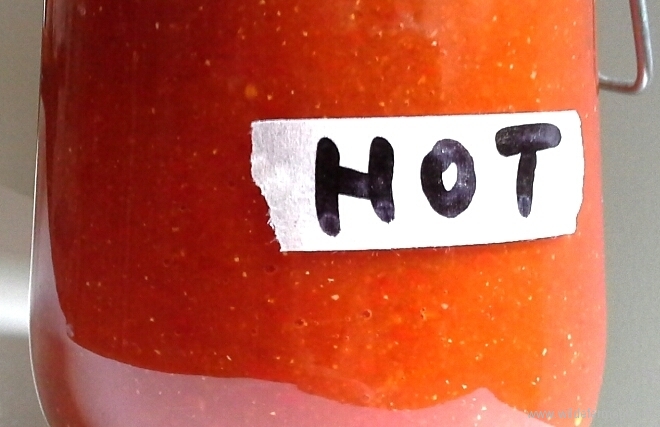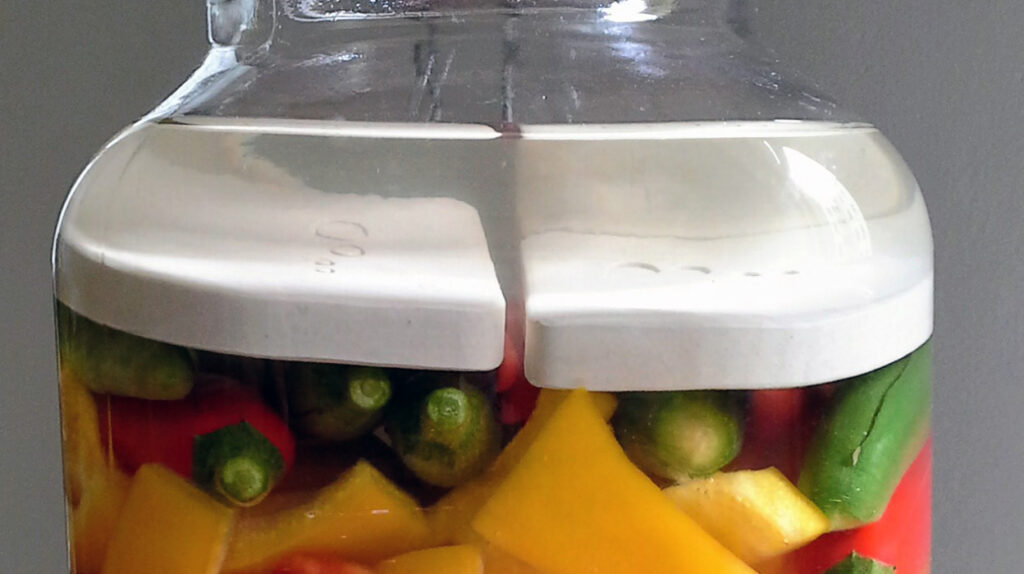Translation by Erin Rieser

The be-all and end-all of any hot sauce is the choice of chilies. If you don’t know anything about chili varieties and the Scoville scale, you should work with Chili de Cayenne as suggested here in this recipe. This type of chili is common, easy to find in organic quality and it has a pleasant degree of spiciness.
If you wish to ferment this hot sauce without any risk of mold growth, you must purée the batch after the wild fermentation has taken place and not before. Puréed mashes, by their very nature, do not allow for anything to be pushed down by a fermentation weight.
If you leave the vegetables as cut pieces until the end of the fermentation, you can easily press these pieces under the brine using weights. Wild fermentation takes place under the brine and there the fermentation is safe. If you also use flip-top jars, the carbon dioxide produced by the bacteria will form an anaerobic phase above the ferment, in which no mold can grow. Bingo.

Hot Sauce
- 1 Tbsp mustard seeds
- 1 small yellow onion
- 1 red onion
- 5 garlic cloves
- 4 red bell pepper
- 1 yellow bell pepper
- 5 green Chili de Cayenne (green cayenne chili pepper)
- 5 red Chili de Cayenne (red cayenne chili pepper)
- 40 g unrefined natural rock salt (=1.41 ounces)
- 2 liters tap water (=8.45 American cups)
- a 3-Liter “Fido” flip-top jar
- ferment weights
- 5 sun-dried tomatoes
- 2 chipotle mora (smoked & dried jalapeños)
First, stir the rock salt into the tap water. While the salt dissolves, prepare the remaining ingredients. Peel the onions and chop them, not too finely. Peel the garlic. Rinse the bell peppers and chilies under running water. Cut the peppers into large pieces. For the chilies: cut off the stem of the cap, but not the whole cap. The cap is edible and will also be fermented. Make a slit in the chilies lengthwise, to prevent their tendency to float.
Transfer the prepared ingredients into the flip-top jar in layers, whereby the smallest ingredients should be placed at the bottom. First the mustard seeds are placed into the jar, then the garlic and onion cubes, followed by the pieces of bell pepper, and finally by the chilies. Weigh everything down with ferment weights and fill the jar up with the 2% brine at least to the shoulder height of the glass. Everything must always be under the brine.
Let this mixture wild ferment in the dark at room temperature for at least six to eight weeks. Look for signs of wild fermentation: happy bubbles form ° o O o ° °° and the brine becomes cloudy.
Once the ferment is thoroughly fermented (the longer it goes, the more rounded the flavor), a portion is taken from the brine to soak the dried tomatoes and chipotle mora overnight.
The following day, purée all the vegetables, adding just enough of the brine to give the sauce a good consistency without it being too watery.
Fill the hot sauce into bottles and store them in the refrigerator. The fully fermented sauce can be kept for at least one year.
A spicy hot sauce, wild-fermented and clean. No thickeners, antioxidants, flavor enhancers, emulsifiers or artificial colorings.
You can find the respective step-by-step instructions by clicking on any of the photos below.













Hallo Hallo Hilferuf!
Ich hab dein Rezept ausprobiert und während der Fermentation so weißlich graue Schlieren im Glas beobachtet. Nachdem nun 8 Wochen rum sind, hab ich mal reingeschaut und an der ein oder anderen Stelle weiße Ablagerungen gefunden, bisschen wie Sandkörner, die sich zb in Kuhlen der Paprikastücke angesammelt haben. Beim Öffnen kam Kohlensäure raus und es riecht gut. Trotzdem bin ich unschlüssig, ob ich vielleicht Schimmel im Glas habe….was meinst du?
Liebe Grüße!
Hallo Maxie,
alles okay und im grünen Bereich. Dass die Lake trüb wird und sich helle Ablagerungen auf dem Fermentiergut bilden, ist völlig normal. Erklärungen findest du in diesem Blogbeitrag: https://www.wildefermente.de/truebelake/
Herzliche Grüße,
Barbara
Vielen Dank! Ist inzwischen schon aufgegessen (zum Teil verschenkt an Freunde) und war so lecker, dass ich schon die nächste Runde angesetzt hab! Deine Seite ist für mich eine entspannte Inspiration und Ermutigung zum Einsteigen gewesen, Danke 🙂
Vielen Dank für die schöne Rückmeldung. 🙂